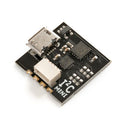I²CMini Core
by Excamera Labs

I²CMini is a USB to I²C bridge. It can drive and monitor I²C traffic and measures just 18 mm square.
It has a micro USB connector, a Qwiic connector on the I²C side, and .1" pins for a breadboard or pin header. I²CMini is 100% compatible with I²CDriver, and like I²CDriver it’s an easy-to-use, open source tool for controlling I²C devices. It has a GUI that works with Windows, Mac, and Linux, and it has first-class Python2/3, C/C++, and command-line tools.
I²CMini is particularly well-suited for applications like IoT and drones, cleanly separating your SBC from the I²C bus. Because it is totally compatible with I²CDriver, you can develop on the I²CDriver and deploy on the I²CMini.
Like I²CDriver, it works equally well with Windows, Mac, and Linux. It uses a standard FTDI USB serial chip to talk to the PC, so no special drivers need to be installed. The board includes a separate 3.3 V supply for your I²C sensors and peripherals.
On the I²C side, I²CMini has the same four-pin header for connecting to peripherals as the I²CDriver. You can solder directly to this .1 " header. It also offers a Sparkfun Qwiic-compatible connector. Qwiic is a new standard for building I²C networks without soldering.

I²CMini comes with free (as in freedom) software to control it from:
- a GUI
- the command-line
- C and C++ using a single source file
- Python 2 and 3, using a module
Like I²CDriver, it can both drive and listen on the I²C bus, and it has the same programmable pullup resistors for both I²C lines.
Who Needs It and Why?
If you want to connect an I²C peripheral to a CPU with USB, I²CMini is the ideal interface. Its straightforward Open Source hardware and software design make it the maker’s choice.
Show I²C Devices Who’s Boss
By controlling I²C hardware using the PC tools you’re most comfortable with, you can get devices doing what you want in a fraction of the development time. Calibrating devices like accelerometers, magnetometers, and gyroscopes is much easier when done directly on the PC.
I²CMini ships with Python examples using small groups of I²C devices to make something useful.
A Tiny Bridge
At 2.1 g and 18 x 18 mm, the I²CMini will fit into the tinyiest projects, so after developing on the full-size I²CDriver, you can drop the I²CMini into small spaces like drones and IoT devices.
A Solid Platform for Your Embedded I²C Network
Because it uses the same proven firmware and toolchain as I²CDriver, I²CMini is the solid, reliable choice for driving your sensors and peripherals. Its a straightforward interface - it appears as a standard serial device - giving you a high level of portability and maintainability. There are no special drivers to install, so code for I²CMini and I²CDriver can work on any platform.

Features
- Open hardware: the design, firmware and all tools are under BSD license
- Fast transfer: sustained I²C transfers at 400 and 100 kHz
- I²C pullups: programmable I²C pullup resistors, with automatic tuning
- Dual I²C ports: a castellated .1" header, plus a Qwiic standard connector
- Jumpers: color coded Qwiic jumper included, for instant connection
- 3.3 V output: output levels are 3.3 V, all are 5 V tolerant
- Supports all I²C features: 7- and 10-bit I²C addressing, clock stretching, bus arbitration
- Sturdy componentry: uses an FTDI USB serial adapter, and Silicon Labs automotive-grade EFM8 controller
- Usage reporting: reports uptime, temperature, and running CRC of all traffic
- Flexible control: GUI, command-line, C/C++, and Python 2/3 host software provided for Windows, Mac, and Linux
Specifications
- Maximum power out current: 270 mA
- Device current: up to 25 mA
- Dimensions: 61 mm x 49 mm x 6 mm
- Computer interface: USB 2.0, micro USB connector
We no longer stock this product
It's sad to say goodbye but sometimes we have to retire products to make way for new things.
You may still be able to buy this product directly from our friends at Excamera Labs - check out their website!
Shop with confidence – we've been serving the hobbyist electronics, Maker, and retro gaming communities since 2012.
- Satisfaction or refund guarantee
- Worldwide shipping via mail or courier
- 57,000+ customer reviews
- Secure website and payments